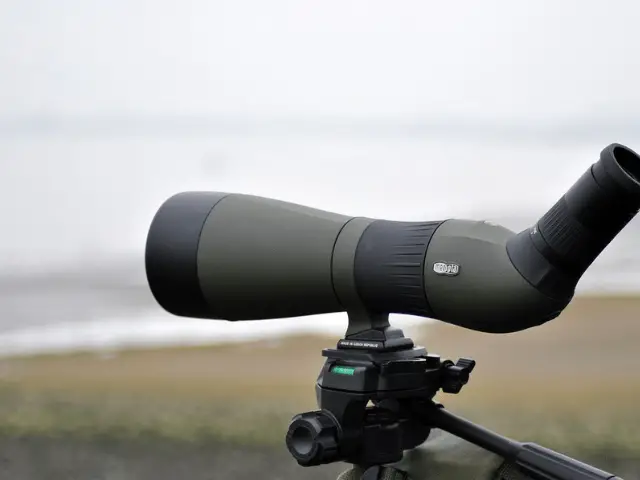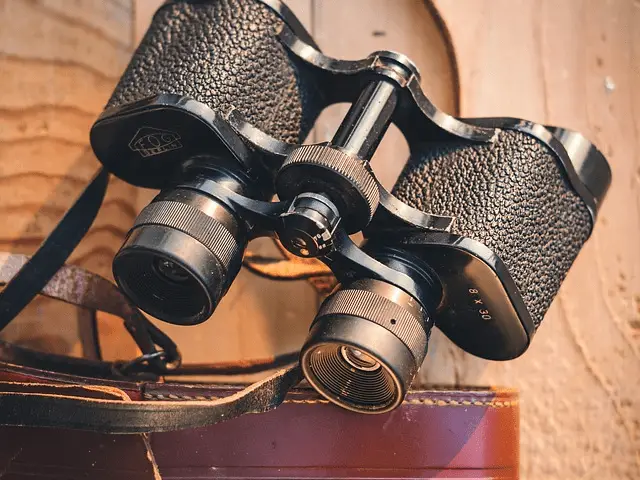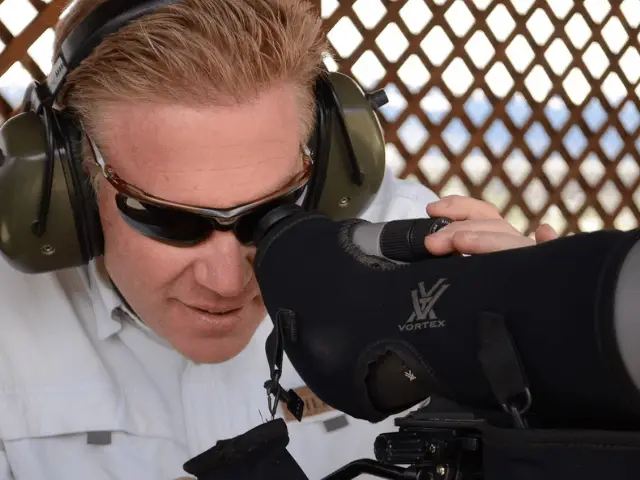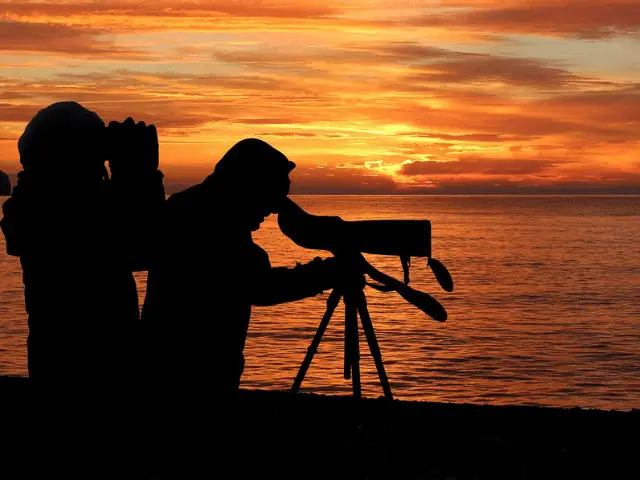It can be downright confusing when you're in the midst of deciding on whether to buy a spotting scope or binoculars.
It is certainly true when you're clueless about how their features vary from one another.
Therefore…
I wrote this article to help you identify the subtle resemblances and disparities between spotting scope vs binoculars.
Hopefully, it will serve as your guide in deciding which of the two you need to enhance your outdoor adventures.
Differences Between Binoculars vs Spotting Scope
The main differences between binoculars vs spotting scope are:
- Binoculars are ideal for handheld use, whereas spotting scopes are generally mounted in tripods for added stability.
- Binoculars offer less magnification power ranging from 1x magnification up-to 12x magnification, whereas a spotting scope offers more magnification power of up to 100x.
- Binoculars feature a larger field of view, whereas a spotting scope has a smaller field of view but allows you to focus on details.
- Binoculars are more compact, lightweight, and conveniently transferable, whereas a spotting scope is less comfortable to use when traveling since it requires support.
Learning More About Spotting Scopes And Binoculars
How It Works
Binoculars use various lenses and prisms to yield a more prominent, clearer view, which is why it is ideal for a broad spectrum of outdoor activities. It allows close observation of distant subjects with your two eyes open.
Hence, the lenses focus light, which occurs as you examine the binos, and a distant subject looks much closer.
Additionally, the prisms inside are responsible for how binoculars are as powerful as telescopes, yet they are shorter. These prisms separate light into different optical paths, from the image to your eyes.
A spotting scope for birding is your mini-sized telescope, a powerful single-tubed optic tool that works best for long-distance viewing.
It typically requires a tripod for steadiness so you can swivel as you view. Unlike the binoculars that allow you to view subjects using both eyes, you have to keep an eye closed when you're using a spotting scope.
Some spotting scope eyepieces are straight, while some are angled, but all in all, the spotting scopes are larger than the binoculars and have more powerful magnification too.
Most people use it for astronomical observation or anything that requires viewing targets from excessive distances.
Magnification Power
Substantially, binoculars are two equally powerful mini telescopes that work in perfect synchronization to view moving subjects that should be in the same place.
Spotting scopes have excellent magnifications outside the reach of standard binoculars, one of their significant advantages. The magnification eyepieces holding the ocular lenses often range from 15x to 100x maximum power.
So, with regards to magnification capabilities, the spotting scope is the clear winner. Some spotting scopes already include eyepieces, while some do not.

Brightness/Low-Light Capabilities
The type of glass and the number of lens coatings determine the binoculars' light transmission capabilities. Generic glasses are often prone to image flaws like skewed colors or some distortion around the edges, whereas a quality glass results in a brighter, sharper view.
Besides, binocular lens coatings are responsible for increasing contrast and reducing scattered light.
For this reason, spotting scopes are at a slight disadvantage in surroundings with faint light since it's the ability to gather more light that will allow you to still see in darkness.
Viewing Angle
You might be wondering, are spotting scopes better than binoculars with regards to flexibility of viewing angles?
Binoculars undoubtedly have a limited viewing angle compared to spotting scopes since they are straight, so you only have the discretion of pointing them where you want to look.
On the contrary, you may use your spotting scope at a natural, comfortable viewing angle. It can either be straight or angled; you will have the flexibility to choose a more convenient configuration for you when you're using a spotting scope.
Nevertheless, an angled view is a popular choice among casual users and birders. It is also the best choice when sharing it with a group; you have a smaller tripod or viewing soaring birds on top of tall trees.
On the contrary, hunters like a straight view even better; it also reduces neck strain, easier to use for the inexperienced, and viewing birds on the ground.
Field Of View
When lenses have high-powered magnification, they tend to have a minimal field of view.
Binoculars have a more extensive field of view, making it simpler to find your subject, except for binoculars with higher magnification.
Scopes might have higher magnification than binoculars, but it is at the cost of a better field of view. If focusing on details is not a primary concern for you, then having a limited field of view won't be much of an issue at all.
Portability
Between binoculars vs spotting scope, the former is generally more portable because of its lightweight design. You can even carry the more compact models around your neck or readily have them in your pocket when you're on the go.

Not even a spotting scope in a carrying case can be portable enough like the binoculars. Although some manufacturers nowadays are getting more creative in finding ways to give spotting scope users more mobility than before.
When To Choose A Spotting Scope vs Binoculars
When you have to make a difficult choice between these two optical devices, go for the one you will enjoy using the most and will suit your needs.
- Digiscoping
- Astronomy
- Target shooting
- Hunting
- Nature study
- Wildlife viewing
- Surveillance of properties, people, etc.
- Long-distance bird watching
Binoculars work best for the following activities:
- Short field hunting using the best hunting binoculars under $500
- When taking a long look or scanning an area
- Spotting game or tracking
- Watching sports events or concerts

Familiarizing With Commonly Used Terminologies
10x42, Etc.
Besides being a designation for different binoculars models, the primary number is the power to enlarge subjects, and the second one is the objective lens diameter, also known as the aperture.
Diopter
So when you see the term diopter adjustment, it only means having the capacity to focus one eyepiece independently for more clarity and focus between your eyes.
In binoculars, it is the retractable ring on the core focus wheel or the right eyepiece.
Close Focus
It indicates the closest distance that binoculars can focus, with anything between 6 and 12 feet as ideal. Every binocular comes with a distinct capability to focus conveniently at a definite distance.
Armoring
The armoring or the external coating, often in rubber, enhances user comfort, making the device easier to grip while providing increased durability.
Field Of View
When you look through the binoculars or spotting scopes, the space you can see is what you call the field of view. Having a large one makes locating the subject more convenient.
Eye Relief
It is the optimal distance of your eyes to the ocular lens, typically measured in millimeters. This feature varies per model and a vital characteristic for those wearing eyeglasses.
Lens Coating
These are chemical treatments applied to the lens's surface to improve the transmission of light, brightness, color quality, and better image clarity. The multi-coated lenses nowadays are the top standard.
Objective Lens
It is the lens nearest to your subject, with measurement in millimeters. It can be up to 100mm in spotting scopes, while in binoculars, it ranges from 25mm to 100mm.
Magnification Power
It refers to how the subject is made larger than how the unaided eye perceives it. However, with greater magnification also comes more difficulty in targeting.
How To Clean Your Spotting Scope Or Binoculars
- You can either use a soft brush or compressed air for removing coarse particles like dust, grit, crumbs, etc.)
- Dampen a part of the lens cloth or tissue with a unique cleaning solution for coated lenses. It is available at camera shops and retail stores.)
- Wipe the lenses gently with the damp cloth.
- Use the dry portion of the cloth to polish the lenses
- Bring it to a well-lighted area to check for spots and smears.
- Repeat the wet cleaning process as necessary.
Watch this video to understand more how to clean and store your binoculars:
Final Thoughts
With all these things considered, I hope it will guide you in making the right choice between the spotting scope or binoculars. Both can provide you with unique benefits and can be gamechanger in your hunting adventures or viewing wildlife.
Both of these optics are invaluable tools that can be costly, so ensure that you take your time to decide which of these two you need the most. It adds up to knowing your needs to figure out the best tool that will fulfill them.

